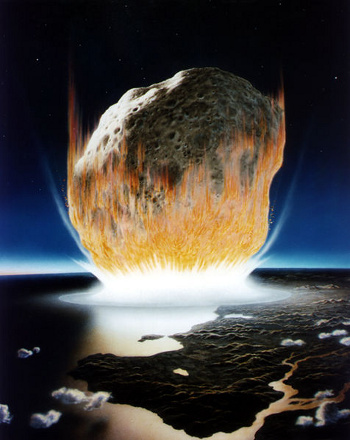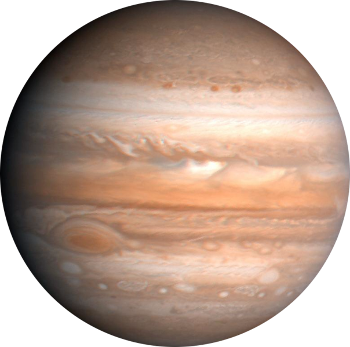Rogue Asteroids
February 28, 2014
I didn't watch any of the recent
Winter Olympic Games. In a
telephone call, my mother reminded me that I was glued to our
monochrome television receiver during the
Olympics when I was a child. In my dotage, I've become anti-
sports for two reasons. Sports has become too
commercialized, and there are too many
injuries.
I personally don't like the idea of
athletic directors typically being paid more than every
professor at their
college. As an example of injuries, there's the
NFL player concussion problem. It's been a problem for decades, but it's just now newsworthy.
There was a part of this year's Winter Olympic Games linked to
science. On February 15, seven Olympic
gold medal winners also received fragments of the
Chelyabinsk meteor which exploded over the
Russian city of
Chelyabinsk.[1] That date was the first
anniversary of the meteor explosion.
Before the Chelyabinsk meteor, Russia was famous for another probable meteor impact, known as the
Tunguska event, that occurred a little more than a
century earlier, on June 30, 1908. Since this event happened in a remote area, there have been many
hypotheses about its cause. Although recent
research indicates it was a
meteor impact, there have been
other theories. I remember seeing
tabloid stories suggesting that the event was the crash of an
alien spacecraft.

There goes the neighborhood!
Artist's depiction of the meteor impact thought to be associated with the Cretaceous–Paleogene extinction event 65 million years.
This impact of a massive meteor was the likely cause for dinosaur extinction, and it's a reminder that we should take steps to prevent our own extinction.
(NASA illustration by Don Davis, via Wikimedia Commons.)
As I wrote in a
previous article (Asteroid Deflection
April 19, 2012), humans finally have the capability to track asteroids, launch spacecraft to their vicinity, and deflect them from impact with the Earth. Near-Earth object are now tracked by various Spaceguard projects, and several notable such objects have been discovered.
Near-Earth asteroid 2000 EM26, which is about 270 meters in size, passed within 1.6 million miles of Earth at about 02:00 UTC on February 18, 2014. This distance is just 8.8 lunar distances. However, a much ballyhooed webcast of the flyby was disappointing because of equipment failure.
2012 EG5 is a near-Earth asteroid discovered on March 13, 2012. It's notable for its passage within 0.001539 AU of Earth just two weeks later on April 1, 2012. This distance is a little more than half the lunar distance.
2012 EG5, at 47 meters in diameter, may be larger, but the smaller 2012 DA14 (30 meters) still packs about 40,000 metric tons of planet-busting potential. On February 15, 2013, this asteroid passed Earth at just 27,743 kilometers (17,239 miles) above its surface, which is closer than a geosynchronous orbit. It was a coincidence that it passed Earth near the time of the Chelyabinsk meteor, since the objects are in different orbits and are unrelated.
The impact threat of the 140 meter diameter asteroid, 2011 AG5, once thought to be high, has been downgraded now that more accurate orbital measurements have been made. Near Earth asteroid 99942 Apophis is worthwhile watching, since it's 325 meters in diameter. Although asteroids of this size are known to impact the Earth about every 80,000 years, Apophis poses no immediate threat.
NASA has proposed several methods to prevent an asteroid from impacting Earth.[1-2] Some of these are based on a single, high energy event of many movie plots. The best techniques, however, are those that slowly nudge the asteroid's orbit while it's still at a distance from the Earth. The necessary preparations could be done during one near Earth encounter to prevent an impact on the next.
The slow pushing could be effected by the small momentum of photons, either by having satellite-based solar-powered lasers bombard the asteroid with powerful light beams, or by the Yarkovsky effect. The Yarkovsky effect is based on the anisotropic radiation of thermal photons.
.jpg)
Weapon of mass extinction lurking at the edge of the Solar System.
(European Southern Observatory Image, via MIT.)
All this effort in detecting possible asteroid impacts has had the side effect that much scientifically useful data are being collected. Francesca DeMeo of the Massachusetts Institute of Technology Department of Earth, Atmospheric and Planetary Sciences and the Harvard-Smithsonian Center for Astrophysics, along with Benoit Carry of the Paris Observatory and the European Space Astronomy Centre (Madrid, Spain) have just published a map that charts the size, composition, and location of more than 100,000 asteroids in our Solar System.[4-5]
DeMeo and Carry started with data from the Sloan Digital Sky Survey. Along with the survey's spectral images of hundreds of thousands of galaxies were data from more than 100,000 Solar System asteroids. One problem they needed to sort out was that of a possible observational bias. Larger asteroids are brighter and easier to observe, so there's the possibility that the smaller ones are underrepresented.[5]
Asteroids represent the primordial matter of the Solar System that eventually coalesced and differentiated into planets.[5] Several decades ago, it was thought that most asteroids were static; that is, they remained in place wherever they formed in the Solar System. Since that time, astronomers have discovered considerable compositional variation in local asteroid populations, with some asteroids near the Sun having the same composition as asteroids at the edge of the Solar System.[5]
Scientists have considered these asteroids to be uncommon, and they're called "rogue" asteroids.[5] DeMeo and Carry's survey shows that such rogue asteroids are quite common, particularly in the asteroid belt between Mars and Jupiter. This indicates that the Solar System has been a dynamic place, perhaps with planets in different orbits than we see today.
Jupiter, in particular could have caused a major disruption of asteroid orbits.[4-5] Says DeMeo,
"It's like Jupiter bowled a strike through the asteroid belt... Everything that was there moves, so you have this melting pot of material coming from all over the solar system."[5]
This research gives further credence to the "Grand Tack" model in which the orbit of Jupiter was at the orbit of Mars in the first few million years of the Solar System.[6] During its orbital migrations, Jupiter would have scattered the orbits of many of the asteroid belt asteroids.[5]
This early "pinballing" of asteroids around the solar system would have led to numerous impacts with Earth. Cold asteroids containing water ice would have been moved from the edges of the Solar System to Earth, and their water made Earth into the "pale blue dot" we have today.[5]

Jupiter, as imaged by the Voyager spacecraft in 1979.
This image was processed by the U.S. Geological Survey to enhance the color.
The orbit of Jupiter may have changed over time, disrupting the orbits of the asteroid belt asteroids.
(NASA/JPL image, via Wikimedia Commons.)
References:
- Miriam Kramer, "Huge Asteroid to Fly Safely By Earth Monday: Watch It Live," Space.com, February 15, 2014.
- Report to Congress: Near-Earth Object Survey and Deflection Analysis of Alternatives, National Aeronautics And Space Administration, March 2007 (PDF File).
- Final Report of the Ad Hoc Task Force on Planetary Defense, NASA Advisory Council, Dr. Tom Jones and Mr. Rusty Schweickart, Co-Chairs, October 6-7, 2010 (PDF File).
- F. E. DeMeo and B. Carry, Solar System evolution from compositional mapping of the asteroid belt, Nature, vol. 505, no. 7485 (January 30, 2014), pp. 629-634.
- Jennifer Chu, "Rogue asteroids may be the norm," MIT Press Release, January 29, 2014.
- Kevin J. Walsh, Alessando Morbidelli, Sean N. Raymond, David P. O'Brien, Avi M. Mandell, "A low mass for Mars from Jupiter’s early gas-driven migration," Nature, vol. 475, no. 7355 (July 14, 2011), pp. 206-209. Available also at Kevin J. Walsh, Alessando Morbidelli, Sean N. Raymond, David P. O'Brien, Avi M. Mandell, "A low mass for Mars from Jupiter’s early gas-driven migration," arXiv Preprint Server, January 22, 2012.
- Z. Ivezić, et al., "Solar System objects observed in the Sloan Digital Sky Survey commissioning data," Astronomical Journal, vol. 122, no. 5 (November, 2001), pp. 2749-2784. (The original article on asteroid measurements from the Sloan Digital Sky Survey, with spectra for more than 100,000 asteroids.)
- Wikipedia list of asteroid close approaches to Earth.
Permanent Link to this article
Linked Keywords: Winter Olympic Games; telephone; monochrome; television receiver; Olympic Games; Olympics; sports; commercialized; injury; athletic director; professor; college; NFL player concussion problem; science; Olympic medal; gold medal; Chelyabinsk meteor; Russia; Russian; Chelyabinsk; anniversary; Tunguska event; century; hypothesis; research; meteor impact; conjecture; tabloid; alien spacecraft; Cretaceous–Paleogene extinction event; dinosaur; extinction event; NASA; Wikimedia Commons; human; asteroid; Near-Earth object; Spaceguard; 2000 EM26; meter; mile; Earth; Coordinated Universal Time; UTC; lunar distance; webcast; 2012 EG5; astronomical unit; AU; 367943 Duende; 2012 DA14; metric ton; kilometer; geosynchronous orbit; coincidence; orbit; 2011 AG5; 99942 Apophis; NASA; energy; movie; plot; momentum; photon; satellite; slar energy; solar power; laser; Yarkovsky effect; anisotropy; anisotropic; radiation; infrared; thermal photon; European Southern Observatory; Massachusetts Institute of Technology; MIT; science; scientific; Francesca DeMeo; Department of Earth, Atmospheric and Planetary Sciences; Harvard-Smithsonian Center for Astrophysics; Benoit Carry; Paris Observatory; European Space Astronomy Centre (Madrid, Spain); map; Solar System; Sloan Digital Sky Survey; astronomical spectroscopy; galaxy; observational bias; apparent magnitude; coalescence; coalesce; planetary differentiation; astronomer; Sun; asteroid belt; Mars; Jupiter; pale blue dot; U.S. Geological Survey.